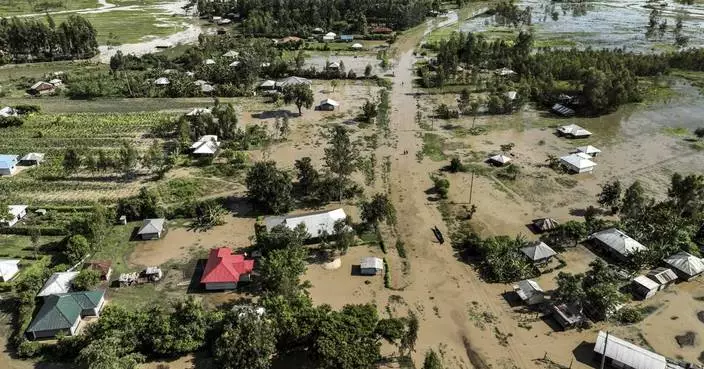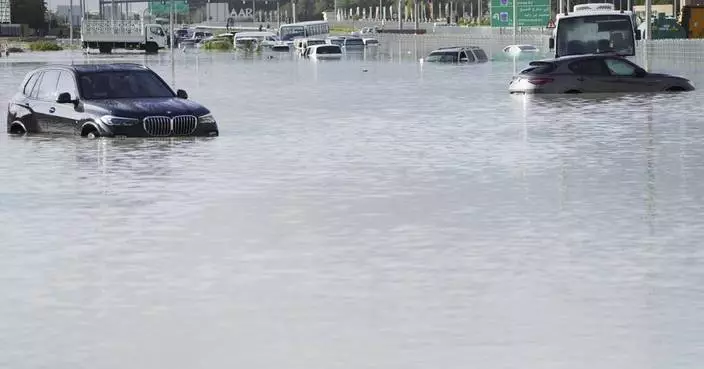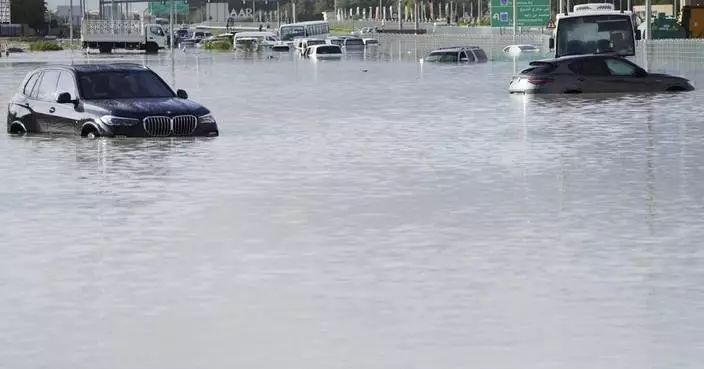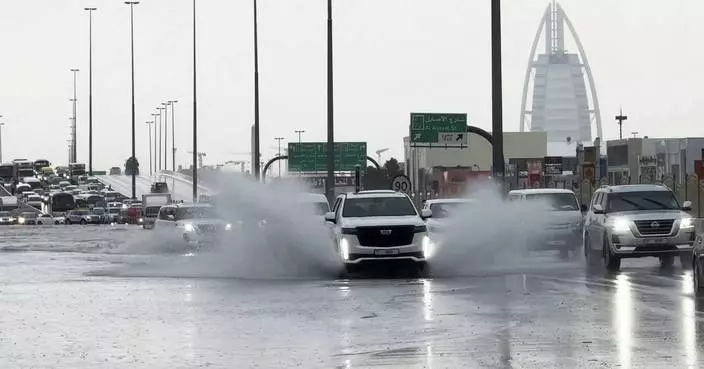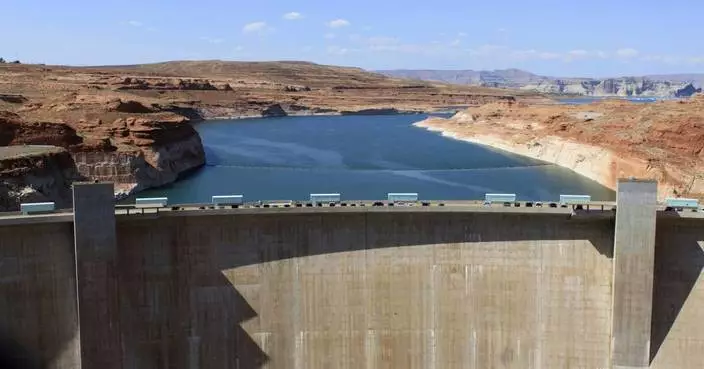undreds of tourists who booked coveted overnight trips on tribal land deep in a gorge off the Grand Canyon will have to reschedule after heavy flooding forced evacuations and shut down the area for at least a week.
Abbie Fink, a spokeswoman for the Havasupai Tribe, said 300 people had reservations for either the campground or the lodge in the next several days. Crews were assessing the damage Friday to determine when it's safe for visitors to return.
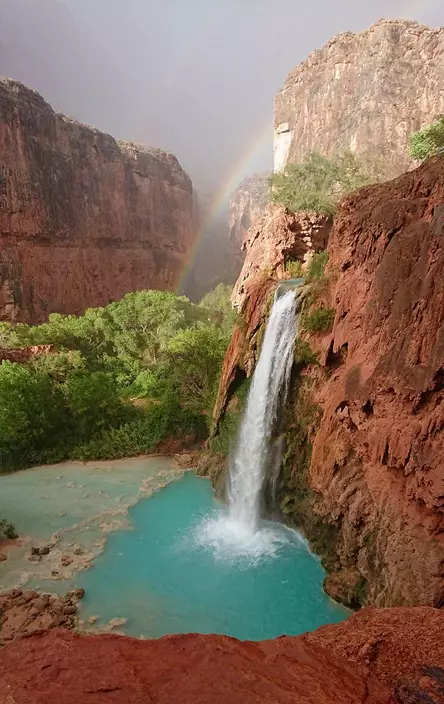
This Wednesday, July 11, 2018 photo released by Benji Xie shows a rainbow over a waterfall on the Havasupai reservation in Supai, Ariz. (Benji Xie via AP)
"Every day it's closed, it's another set of people impacted by it," she said.
The remote reservation outside Grand Canyon National Park is best known for its towering blue-green waterfalls that appear like oases in the desert. The tribe doesn't allow day hikers, so visitors have to reserve overnight trips. The reservations fill up quickly.
Andrea Molina saw only two dates available until 2020 when she checked earlier this year. She and her partner booked a trip for Friday, rented camping gear and reserved a pack mule for the trip from Phoenix.
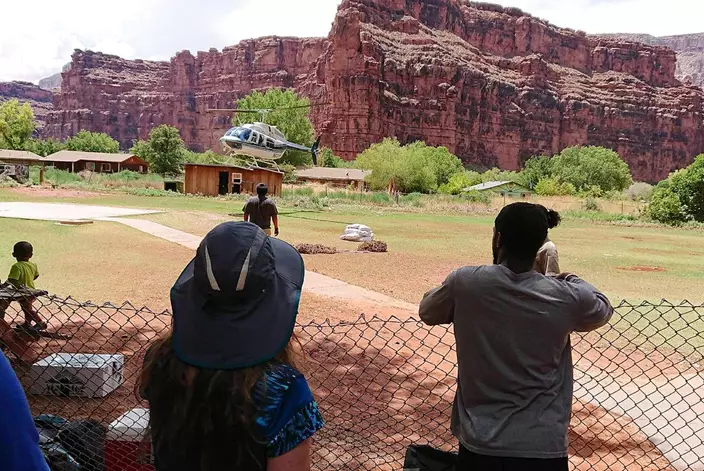
This Thursday, July 12, 2018 photo released by Benji Xie shows a helicopter landing to rescue people from flooding on the Havasupai reservation in Supai, Ariz. (Benji Xie via AP)
She was looking forward to the challenging 10-mile (16-kilometer) hike down a winding, dusty trail to the campgrounds on her 34th birthday. But she felt grateful she wasn't amid flooding this week that sent tourists scrambling as a shallow creek rose several feet.
She said she won't be able to recoup all the costs but will try next week to rebook.
"We're just going to enjoy the day, maybe do a small hike and make the best out of it," she said Friday.
The flooding hit just before dark Wednesday and again before sunrise Thursday, forcing the evacuation of about 200 tourists. Some, wearing only their swimsuits, had to abandon their camping gear.
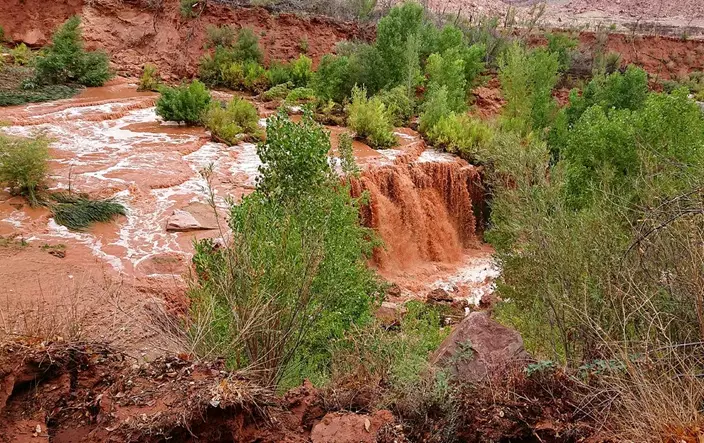
This Thursday, July 12, 2018 photo released by Benji Xie shows flooding from a waterfall on the Havasupai reservation in Supai, Ariz. (Benji Xie via AP)
Footbridges collapsed, tents were buried in sand and debris strewn about as water rushed over the landscape. Campers sought refuge on benches, in trees and in caves. The existing waterfalls turned a muddy brown, and new ones emerged from the steep walls of the canyon.
Christian Raftopol and the three others in his group planned to hike out at 3 a.m. Thursday and were packing when the rain started falling. They ducked into their tents, but he said the water levels rose quickly and he warned others.
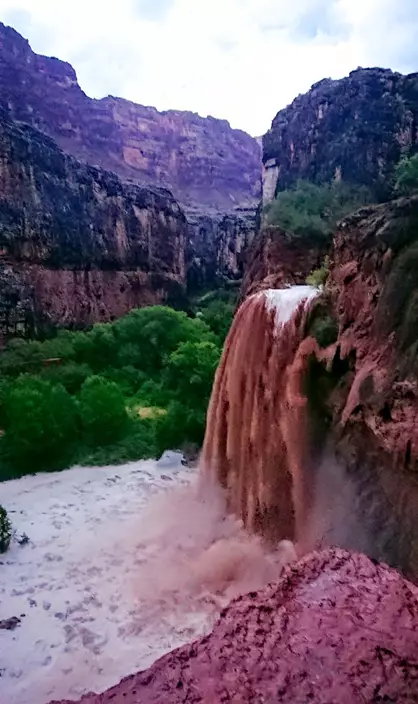
This Wednesday, July 11, 2018 photo released by Benji Xie shows flooding from a waterfall on the Havasupai reservation in Supai, Ariz. (Benji Xie via AP)
He fled to a nearby restroom after pulling fellow campers from their tents. He thought they were close behind but saw them fall into the water after a footbridge broke and was swept away. They were able to trudge through to join him and later used headlights to hike to the tribal village, he said.
"It was furious," the Mount Vernon, New York, resident said.
Raftopol said they tried to form a human chain to help other campers stuck on an island but couldn't and advised them to go another direction. Meanwhile, he saw a man using a wooden pole to guide himself through the water to reach tourists farther down in the campground.
All but 17 of the tourists were able to get to the community center in Supai village and spent the night. The others left at sunrise Thursday after the water receded, Fink said.
The tribe opened a small store in the village for tourists and didn't charge for food or water. Tourists and tribal members gave out socks and shoes, tourists said. A lodge on the way to the canyon offered free showers and breakfast to the evacuees.
U.S. Bureau of Indian Affairs spokeswoman Nedra Darling said the agency hasn't received a damage estimate but assisted in evacuating the tourists.
The canyon is accessible only by foot, helicopter or mule ride. About 400 tribal members live there year-round.
Eric Kremer was one of the last out Thursday and reveled in the experience from his home in Las Vegas on Friday after a shower, food and a beer.
"I never felt my life was threatened while I was there," he said. "Obviously that's in the control of Mother Nature. It wasn't up to me."
Between 10% and 40% more rain fell in just one day last week — killing at least two dozen people in the United Arab Emirates, Oman and parts of Saudi Arabia — than it would have in a world without the 1.2 degrees Celsius (2.2 degrees Fahrenheit) warming that has come from the burning of coal, oil and natural gas since the mid-19th century, scientists at World Weather Attribution said Thursday in a flash study that is too new to be peer-reviewed.
In at least one spot, a record 11 inches (28.6 centimeters) of rain fell in just 24 hours, more than twice the yearly average, paralyzing the usually bustling city of skyscrapers in a desert.
One of the key tools in WWA's more than 60 past reports has been creating computer simulations that compare an actual weather event to a fictional world without climate change, but in the Dubai case there wasn’t enough data for those simulations to make such a calculation. But analysis of decades of past observations, the other main tool they use, showed the 10% to 40% bump in rainfall amounts.
Even without computer simulations, the clues kept pointing at climate change, scientists said.
“It’s not such a clear fingerprint, but we have lots of other circumstantial evidence, other lines of evidence that tell us that we see this increase,” said Imperial College of London climate scientist Friederike Otto, who coordinates the attribution study team. “It’s what we expect from physics. It’s what we expect from other studies that have been done in the area, from other studies around the world, and there’s nothing else that’s going on that could explain this increase.”
There is a long-known effect in physics that finds the air holds 7% more moisture with every degree Celsius (4% for every degree Fahrenheit).
Otto said she has confidence in the conclusion, but said this was one of the harder attribution studies the team has undertaken.
El Nino, which is a natural occasional warming of the central Pacific that changes weather systems worldwide, was a big factor, the report said. These heavy Gulf downpours have happened in the past but only during an El Nino. And the researchers said those past deluges seem to be trending heavier — something scientists have long said would happen in many parts of the world as the world warms.
This flooding, which came from two separate and near simultaneous storm systems, would not have happened without El Nino, said study co-author Mansour Almazroui of the Center of Excellence for Climate Change Research (CECCR), King Abdulaziz University in Saudi Arabia. Nor would it have been like this without human-caused climate change, Otto added.
Because rainfall amounts varied over the region and the lack of data, the report couldn't put a figure on if climate change had increased the likelihood of downpours like this in Dubai, but Otto estimated that it's probably about three times more likely to happen now than in pre-industrial times.
The report and its authors threw cold water on speculation that UAE cloud seeding had anything to do with the amount of rain or its likelihood. Many scientists dispute cloud seeding's effectiveness in general. Even so, the clouds in the storm system were not seeded, the report said. And the results of cloud seeding, if any, in general are more immediate, Otto said. And this storm was forecast days in advance.
“This type of rainfall never comes from cloud seeding,” Almazroui said in a Thursday news conference.
While the authors use well-established techniques and this is what scientists expect with climate change, when there's a disagreement between computer simulations and observations, conclusions shouldn't be drawn, said University of Victoria, Canada, climate scientist Andrew Weaver, who wasn't part of the research.
It's a strong enough case that greenhouse gas emissions are a factor, several other outside scientists said.
University of Melbourne, Australia, climate scientist Malte Meinshausen called Thursday’s study “a well-balanced, impressively detailed and adequately cautious assessment.”
“This work, when combined with theory and attribution studies associated with the increasingly frequent other extreme rain and flooding events around the world, makes the convincing case that climate warming supercharged the recent extreme rainfall and flooding event UAE and Oman,” said climate scientist Jonathan Overpeck, dean of the University of Michigan's environment school. “This is what global warming increasingly looks like — more severe climate extremes and human suffering.”
__
Read more of AP’s climate coverage at http://www.apnews.com/climate-and-environment
Follow Seth Borenstein on X at @borenbears
The Associated Press’ climate and environmental coverage receives financial support from multiple private foundations. AP is solely responsible for all content. Find AP’s standards for working with philanthropies, a list of supporters and funded coverage areas at AP.org.
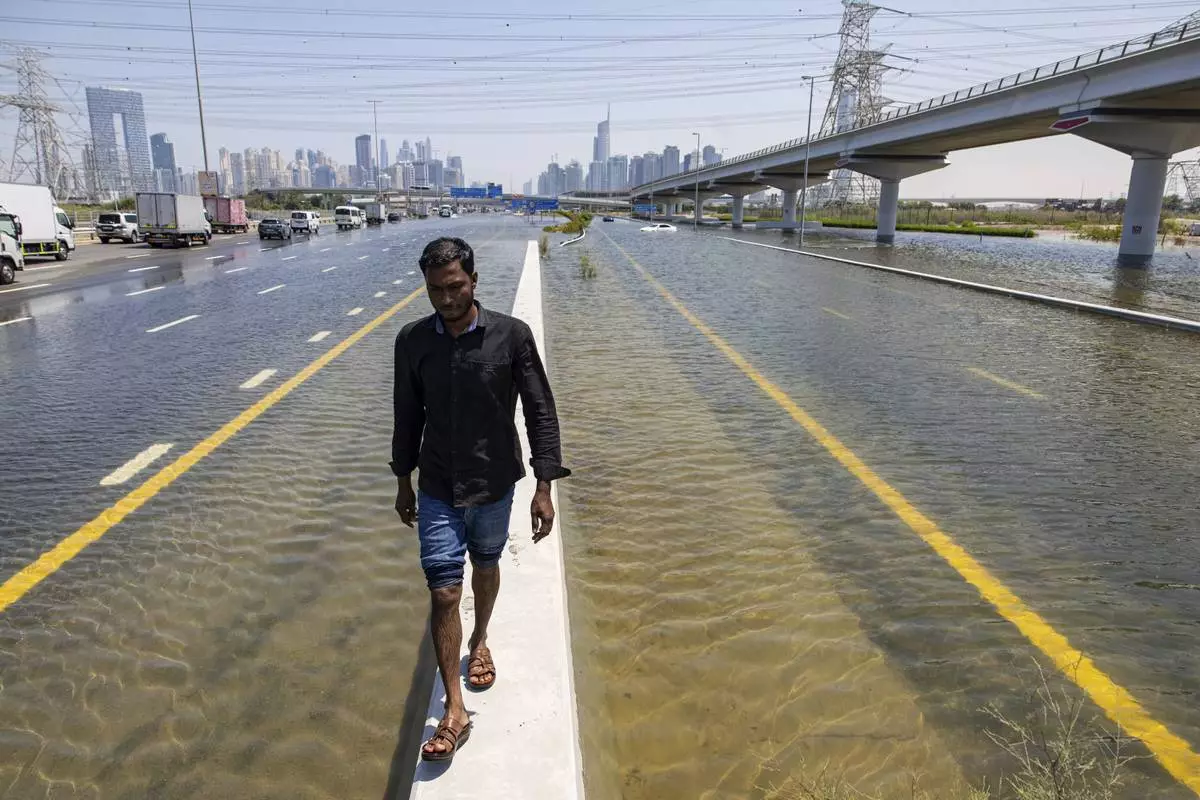
FILE - A man walks along a road barrier among floodwater caused by heavy rain on Sheikh Zayed Road highway in Dubai, United Arab Emirates, April 18, 2024. A new report says climate change played a role in the floods. (AP Photo/Christopher Pike, File)
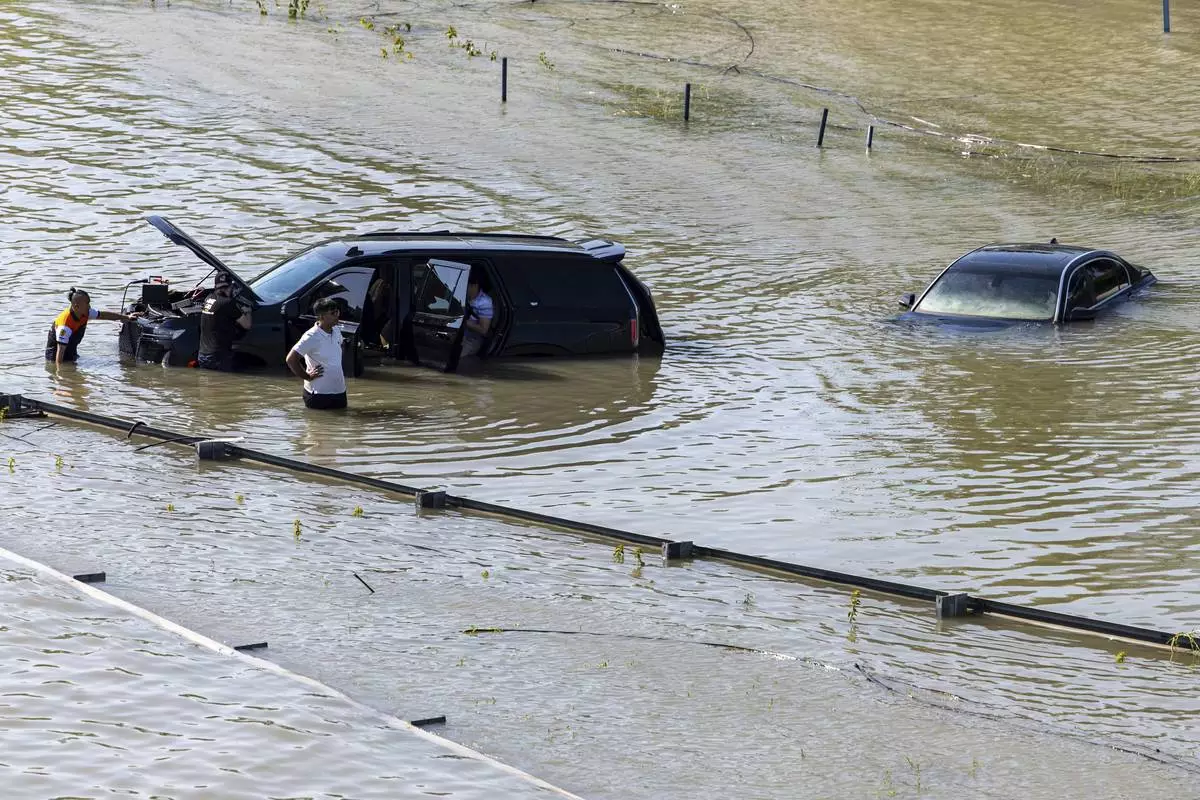
FILE - A group of people work to recover an abandoned vehicle taken by floodwater caused by heavy rain in Dubai, United Arab Emirates, April 18, 2024. A new report says climate change played a role in the floods. (AP Photo/Christopher Pike, File)
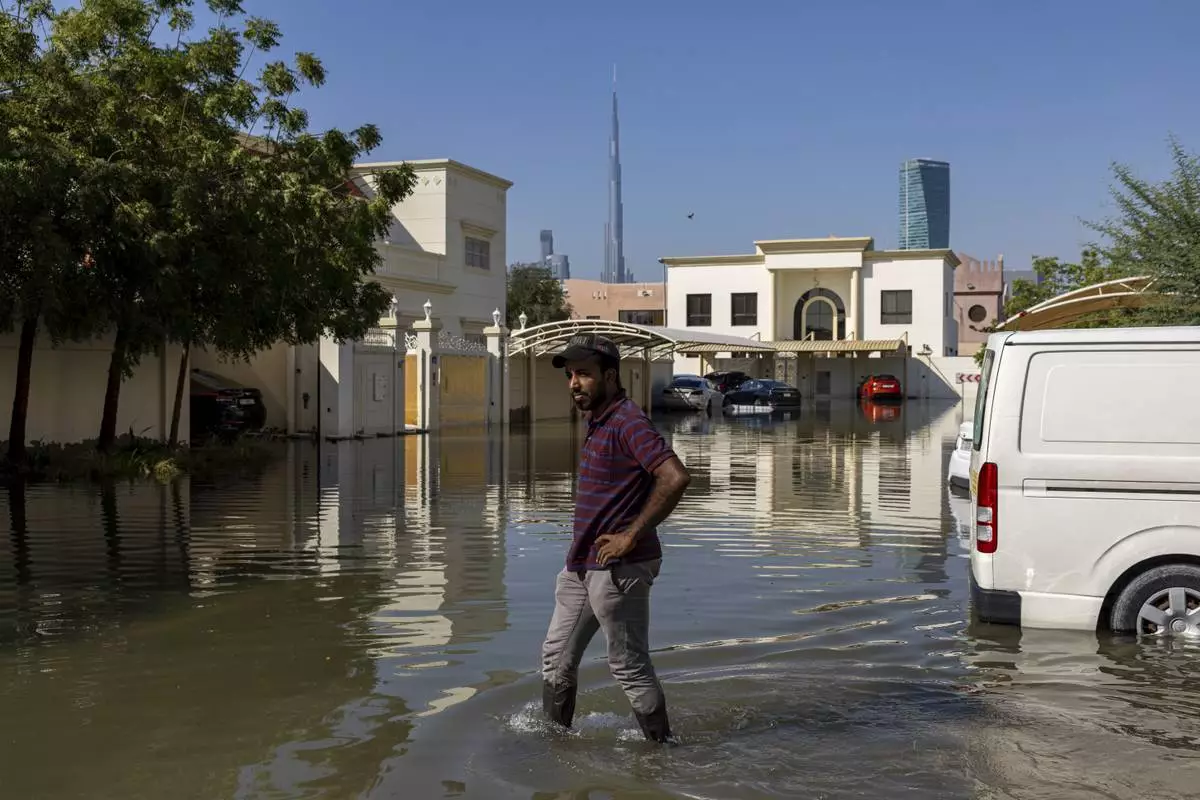
FILE - A man walks through standing floodwater caused by heavy rain with the Burj Khalifa, the world's tallest building, seen in Dubai, United Arab Emirates, April 18, 2024. A new report says climate change played a role in the floods. (AP Photo/Christopher Pike, File)
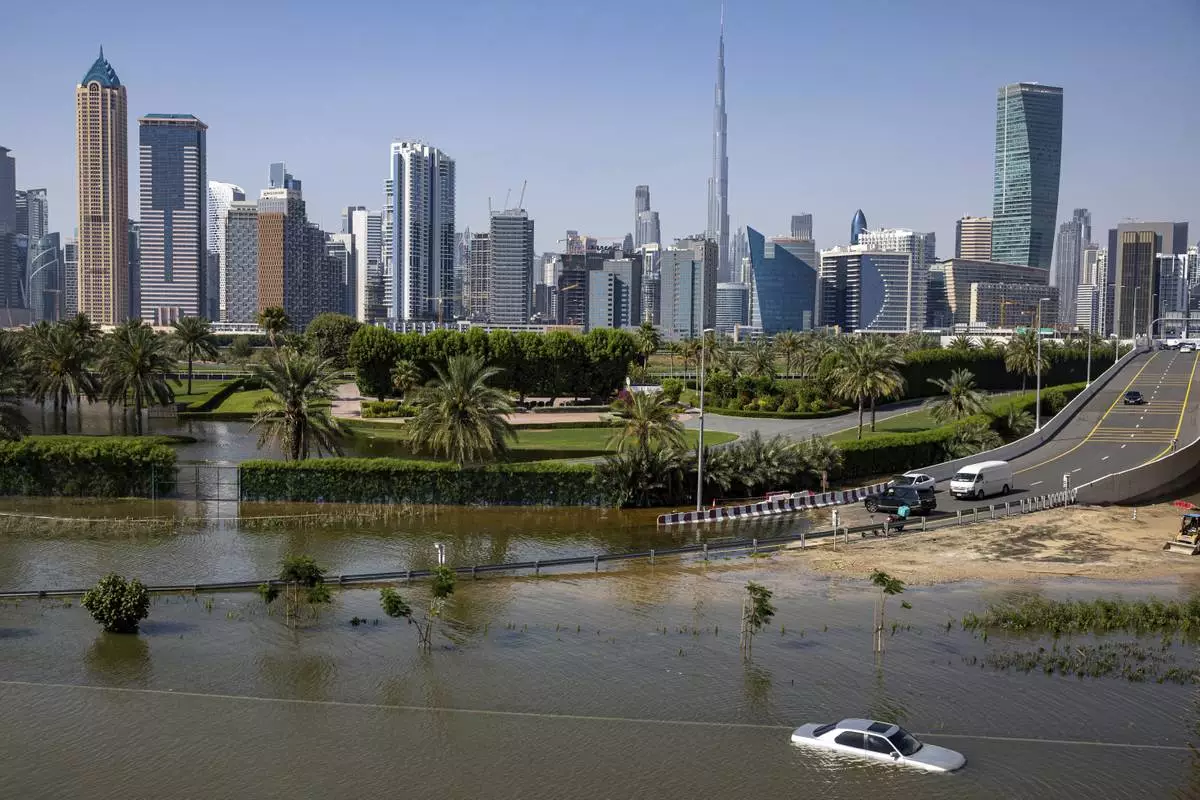
FILE - An abandoned vehicle stands in floodwater caused by heavy rain with the Burj Khalifa, the world's tallest building, seen in the background, in Dubai, United Arab Emirates, April 18, 2024. A new report says climate change played a role in the floods. (AP Photo/Christopher Pike, File)











